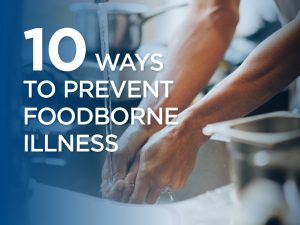
Whatever business you are involved in—manufacturing, construction, school, office or something else entirely—food safety should be on your radar as a possible threat.
You may wonder what food has to do with your business (construction, for example), or you may be more aware because your organization handles food every day (school cafeterias, for example). EMC Industrial Hygienist Adriana Pitcher reminds us that food is available at virtually every workplace, even if manufacturing, processing or serving food is not your core business.
She notes that many companies have an onsite cafeteria, and there are countless company potlucks before holidays, treats brought in to celebrate birthdays, and food carried in by employees for their own lunches and breaks.
Out in the field, construction and landscaping employees may bring their lunches with them each day. Adriana says, “Each of these meals and snacks can pose hazards if not handled properly.” And while an occasional upset stomach may not cause major workplace disruptions, it is harder to cope if everyone in your office calls in sick the day after a holiday lunch.
Just think about cases you’ve heard in the news over the past few years. Multi-state outbreaks have occurred when lettuce and spinach weren’t handled properly during their journey from the field to the consumer. A restaurant chain experienced outbreaks in multiple restaurants because of poor staff training, poor food-chain processes and internal procedures that allowed germs and bacteria to grow.
Nearly any food can be dangerous under the right conditions, from cucumbers and nuts to eggs, meats and even flour. In addition to bacteria, it’s important to keep foods away from chemicals and possible pollutants used by your company.
Tips for Non-Food Businesses
Just because food isn’t your business focus doesn’t mean you can be lax about food handling. Adriana offers these suggestions for keeping foodborne illness at bay:
- Offer a location for employees to eat lunches and take breaks that is away from the workplace. Adriana notes that she has seen construction workers sitting at the site to eat, which poses hazards from any chemicals, dirt and dust present.
- In office or manufacturing settings, having a clean breakroom is important, as is providing refrigeration and easy warm-up options, such as a microwave. Set up a plan to keep appliances, sinks, dishware and tables clean and sanitized so employees don’t pick up an illness on their break.
- Be serious about keeping control over foods brought in for potlucks and treat days. It’s important to know how to safely cook foods, such as meats, to ensure any germs have been killed. Check this chart for a list of foods and temperatures. Use a meat thermometer to ensure the correct temperature is reached.
- One of the primary food safety rules is to keep hot foods hot (above 140 degrees F) and cold foods cold (below 40 degrees F) while holding and serving them. This is true no matter how long you hold the foods on your buffet line or in the break room. Set up hot foods in calibrated warmers. Keep cold foods on ice or in chilled containers. Serve foods promptly and don’t let leftovers sit out all afternoon, allowing employees to come back and nibble.
- As with any food service business, those handling the foods should wash hands before and after handling them, and even better, should wear food-service gloves, too.
Tips for Food Businesses
Businesses involved in the processing, distribution, selling or serving of foods have a host of regulations to follow and often inspections, too. Local health departments, USDA and other agencies offer guidance along with regulations for safely handling and storing foods. In addition:
- Know how foods are handled before you receive them. Food contamination can occur anywhere along the food chain. Not only are you responsible for the foods you are processing or selling, but you also need to be aware of how other links in the chain are handling the raw product, as well as processing procedures and transportation sanitation before foods and ingredients arrive in your facility. Lettuce, for example, can be contaminated in the field by chemicals, irrigation water or the pickers, as well as in dirty trucks. Unless you work closely with your suppliers, you won’t have a clue how the products are handled before they reach your business.
- Implement as many fail-safe procedures as possible. Automated food processing and standardized cleaning procedures, for example, can help achieve consistency.
- Keep up on staff training, particularly on the importance of handwashing, especially if you have a high turnover rate.
- Keep sick workers away from food contact. School food service workers are required to remain out of the food prep area for 72 hours during and after an illness.
- Stay on top of health concerns and new research on food safety. Your public health department is a good source of new information, and the Centers for Disease Control (CDC) issues recalls and public notices of nationwide concern.
For more details on specific related topics, visit USDA’s food safety page.
Info gathered from EMC Insurance
